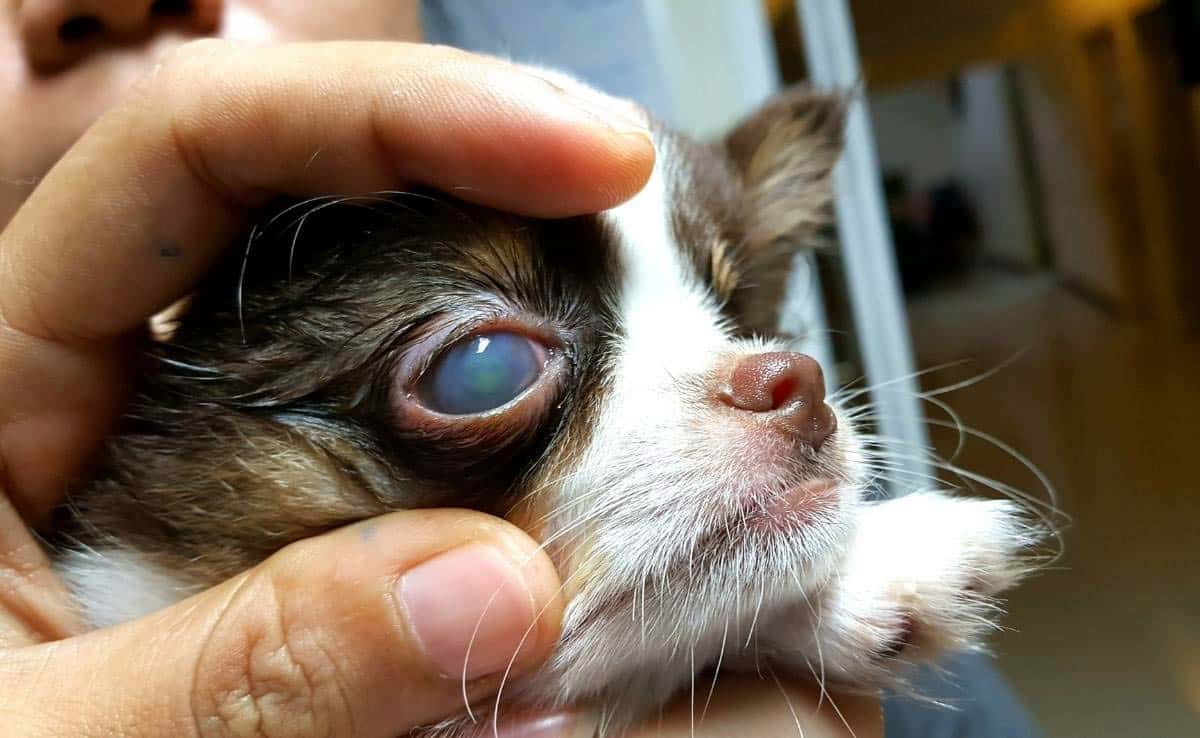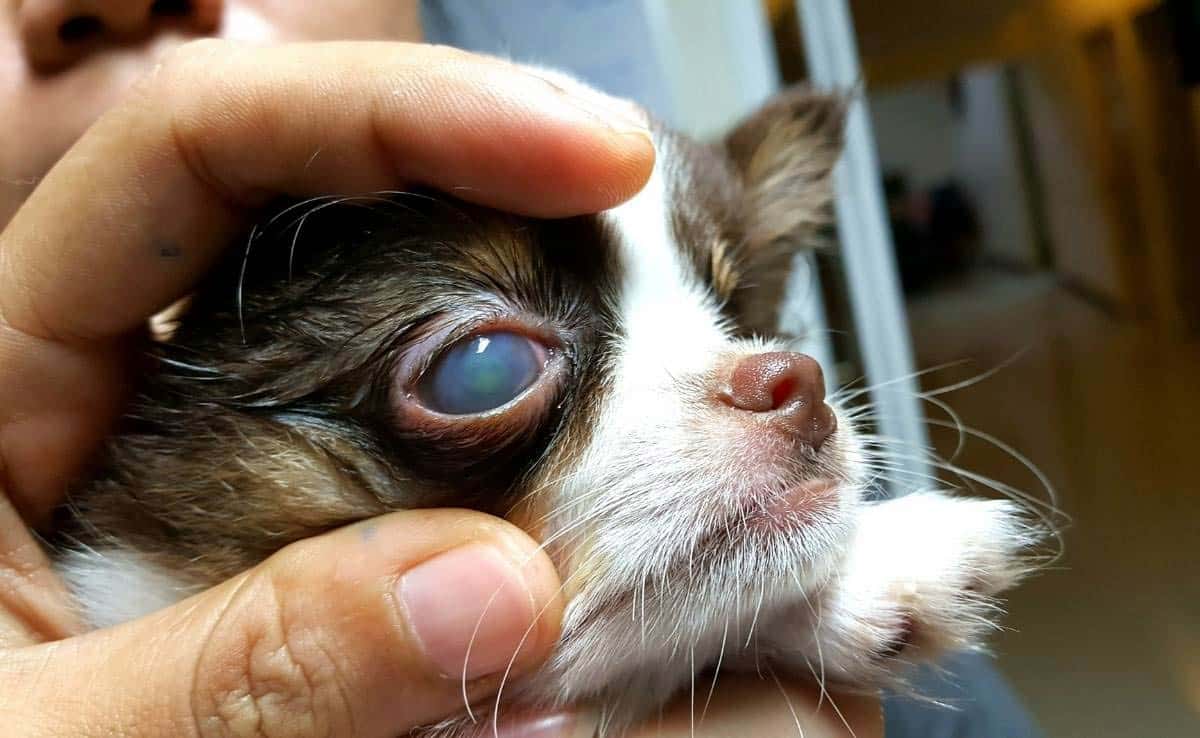
To keep the lights on, we receive affiliate commissions via some of our links. Our review process.

One of the most common problems requiring an emergency visit to the vet is when an owner notices their dog’s eye is sore and red. Very often, the problem is a corneal ulcer. Owners often wonder how these ulcers in a dog’s eye happen, how they are diagnosed and treated, and what eye ulcer healing stages are.
Understanding Corneal Ulcers In Dogs
Contents
The cornea is the outermost layer of the eye. Understanding its anatomy can help explain how dog eye ulcers happen, how they heal, or why sometimes dog eye ulcer treatment isn’t as straightforward as expected.
Layers Of Dog’s Cornea
The cornea has three main layers, which all play specialized roles:
- Stroma – The largest layer in the middle, accounting for 90% of the corneal thickness.
- Descemet’s Membrane – Under the stroma lies this thin layer.
- Epithelium – Above the stroma lies the the epithelium covered by a highly specialized film of tears containing mucus, water, and oil.
Dog Eye Ulcer Terminology
- Corneal Erosion or abrasion – A fairly superficial erosion or scratched cornea.
- Corneal Ulcer – Generally used when the erosion is deeper or into the stroma.
- Descemetocele – When the erosion is even more profound, through the stroma and exposing Descemet’s membrane. Understandably, this is a much more serious issue than a superficial abrasion.
What Can Cause An Ulcerated Cornea In Dogs?
The causes of corneal ulcers in dogs can be either: epithelium loss or compromised corneal protection. Loss of epithelium, the most common, essentially means “damage to the cornea,” such as:
- Rough contact with a bush or a plant, or self-trauma from rubbing the eye or playing
- Foreign body injuries, such as foxtail, sand, or a blade of grass that gets stuck under the eyelid
- Bite or scratch from another animal
- Chemical irritation, such as accidental shampoo in the eye during a bath, being skunked directly in the face, or drywall dust
- Eyelid issues, such as a rolled-in eyelid (entropion), hair growing in the wrong place (ectopic cilia and distichiasis) or eyelid warts, or cancer
- Genetic diseases, certain types of infection, and hormonal diseases (less frequent)
Compromised corneal protection, which is a less common cause, can happen because of:
- Disruption of the all-important film of tears in conditions such as Keratoconjunctivitis Sicca (aka “dry-eye” or KCS) or chronic cherry eye
- Issues with insufficient or ineffective blinking, which can happen with sedative medication or general anesthesia, a nerve problem, or occasionally because of a rolled-out eyelid (ectropion)
In dogs with short snout conformation (brachycephalic breeds), several of these factors are often present at once, making eye ulcers up to 20 times more common and trickier to treat. It is good for these dogs’ owners to be extra informed and vigilant in catching eye ulcers early and staying on top of their healing.
Dog Corneal Ulcer Symptoms And Diagnosis
An ulcer in a dog’s eye is incredibly painful and usually rapidly leads to:
- redness
- squinting
- rubbing of the eye
- increased tear production (or thicker, yellow-green pus)
- cloudy or even bloody cornea
- bloodshot, swollen, or sucked in eyes
- the third eyelid often sticking out and becoming more visible.
Whenever a dog has a painful eye, an owner should have their dog seen by a vet immediately. They usually provide rapid pain relief by numbing the eye, then examining the different layers of the eye with a magnifying tool and special light. Fluorescent dye is used to help highlight where and how deeply the cornea has been damaged and look for any other underlying issues.
Video: Dog With Eye Ulcer
Check out this video to see a dog with an eye ulcer and how they get diagnosed by a vet.
Corneal Ulcer Treatment For Dogs
For a vet, the most important part of treating a corneal ulcer is identifying whether the ulcer is “simple” or “complicated/non-healing.” A simple ulcer only involves the superficial part of the cornea, usually heals within a week, and gets better without the injury progressing deeper into the stroma. Treatment usually involves antibiotic drops or ointment to put into the eye several times a day, and pain relief, such as atropine and anti-inflammatories if needed. An E-collar to prevent eye rubbing is also often essential for most patients.
An eye with a simple corneal ulcer usually becomes much more comfortable within 24 hours of treatment starting, and many ulcers have completely healed in three to four days. This is the case for most ulcers in dogs’ eyes. A complicated or non-healing ulcer involves the stroma and/or persists for more than seven days. There are usually three possible causes for this to happen:
- The underlying cause is still present, such as an eyelid problem causing the ulcer in the first place, decreased tear production, or an underlying degenerative issue.
- The ulcer has become indolent, which means the cornea’s healing process is defective. Rather than allowing normal healing from the bottom-up, indolent ulcers form a lip around the wound. The epithelium struggles to bind with the stroma, even though no infection or ongoing trauma exists to explain it. They are most common in middle-aged dogs and can take weeks or months to heal if no additional intervention exists.
Indolent corneal ulcer treatment usually requires mechanical intervention from the vet to jump-start the healing process, in addition to the regular treatment of a simple corneal ulcer. A few tries might be required, and some dogs need to be sedated or placed under general anesthesia for this to be done properly and have a higher chance of success.
- The ulcer has become infected — this is particularly common in dogs with short noses (brachycephalic breeds) and is a serious problem, so owners beware. These infected ulcers are also called “melting ulcers,” as the stroma gets quite literally digested by bacteria and by the well-meaning immune system trying to fight off the infection. Melting ulcers should be treated as an emergency because of the speed at which they can worsen and cause the dog’s eye to burst (sometimes as quickly as 12-24 hours). So when people wonder, “can a dog’s eye burst as a result of a corneal ulcer?” with an infected ulcer, the answer is, unfortunately, a resounding YES, potentially leading to blindness in that eye.
Treatment for a melting ulcer usually involves drops around the clock for several days, aggressive antibiotic and anti-inflammatory therapy, significant pain relief, and specialized drops to help prevent the stroma from being digested, such as autologous serum for treating corneal ulcers in dogs. A blood sample is taken from the dog and spun down to be delivered as serum drops into the eye.
Dog Eye Ulcer Healing
Owners should carefully monitor the healing of their dog’s eye ulcer to ensure a simple ulcer does not become complicated and infected. Brachycephalic breed owners, in particular, need to stay on top of this. But what are the signs a dog’s eye ulcer is healing or not healing?
The epithelium of the cornea is normally very quick and efficient at regenerating. An eye with a simple corneal ulcer or a superficial abrasion (not involving the stroma) should not only be a lot more comfortable within one or two days but it should be completely healed in a week. These ulcers usually only need one to two rechecks with the vet before the dog can go back to normal life.
For ulcers that are a bit deeper and involve the stroma or Descemet’s membrane, healing is slower, and it’s normal for there to be some cloudiness to the cornea, even for several weeks, with some degree of residual scarring or persistent swelling possible as well. Ulcers often need to be monitored weekly by the vet to make sure they have not become indolent and are continuing to heal properly.
Signs to suggest the eye isn’t healing properly are continued eye pain and squinting, redness, an increase in tears or pus-like discharge from the eye, an increase in the cloudiness of the cornea, and a different color appearing in the eye such as red (blood) or green or yellow (pus). Additionally, dogs may act sore and withdrawn and lose interest in things they normally enjoy.
An eye that was healing and then suddenly becomes painful again can suggest an eye rupture and should be treated as an emergency.
How To Help Your Canine’s Eyes
Canine corneal ulcers are common, and despite being quite painful, a vast majority are thankfully usually very quick to heal with treatment and careful monitoring. However, things can become complicated under certain circumstances. It is good for dog owners to understand how the eye should be healing and what signs to look for and not hesitate to recheck if they are concerned.
Some dog breeds are predisposed to eye conditions, including corneal ulcers. If you’re concerned your dog may be diagnosed with an eye condition during their life, you may want to consider signing them up for pet insurance. Most pet insurance policies cover ulcers and other canine eye conditions as long as it isn’t pre-existing. You can learn more about your options in our pet insurance reviews.
Tagged With: Eyes